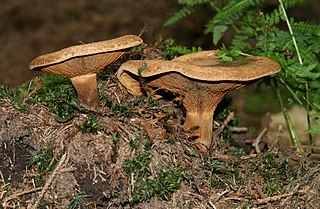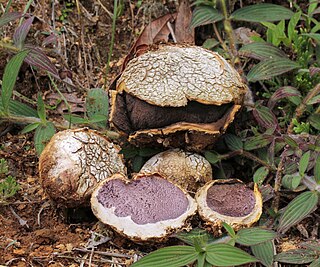
The Agaricales are an order of fungi in the division Basidiomycota. As originally conceived, the order contained all the agarics, but subsequent research has shown that not all agarics are closely related and some belong in other orders, such as the Russulales and Boletales. Conversely, DNA research has also shown that many non-agarics, including some of the clavarioid fungi and gasteroid fungi belong within the Agaricales. The order has 46 extant families, more than 400 genera, and over 25,000 described species, along with six extinct genera known only from the fossil record. Species in the Agaricales range from the familiar Agaricus bisporus and the deadly Amanita virosa to the coral-like Clavaria zollingeri and bracket-like Fistulina hepatica.

The Boletales are an order of Agaricomycetes containing over 1300 species with a diverse array of fruiting body types. The boletes are the best known members of this group, and until recently, the Boletales were thought to only contain boletes. The Boletales are now known to contain distinct groups of agarics, puffballs, and other fruiting-body types.

The Boletaceae are a family of mushroom-forming fungi, primarily characterised by small pores on the spore-bearing hymenial surface, instead of gills as are found in most agarics. Nearly as widely distributed as the agarics, the family is renowned for hosting some prime edible species highly sought after by mushroom hunters worldwide, such as the cep or king bolete . A number of rare or threatened species are also present in the family, that have become the focus of increasing conservation concerns. As a whole, the typical members of the family are commonly known as boletes.

Boletus is a genus of mushroom-producing fungi, comprising over 100 species. The genus Boletus was originally broadly defined and described by Carl Linnaeus in 1753, essentially containing all fungi with hymenial pores instead of gills. Since then, other genera have been defined gradually, such as Tylopilus by Petter Adolf Karsten in 1881, and old names such as Leccinum have been resurrected or redefined. Some mushrooms listed in older books as members of the genus have now been placed in separate genera. These include such as Boletus scaber, now Leccinum scabrum, Tylopilus felleus, Chalciporus piperatus and Suillus luteus. Most boletes have been found to be ectomycorrhizal fungi, which means that they form a mutualistic relationship with the roots system of certain kinds of plants. More recently, Boletus has been found to be massively polyphyletic, with only a small percentage of the over 300 species that have been assigned to Boletus actually belonging there and necessitating the description and resurrection of many more genera.

Hygrophoropsis aurantiaca, commonly known as the false chanterelle, is a species of fungus in the family Hygrophoropsidaceae. It is found across several continents, growing in woodland and heathland, and sometimes on woodchips used in gardening and landscaping. Fruit bodies (mushrooms) are yellow–orange, with a funnel-shaped cap up to 8 cm across that has a felt-like surface. The thin, often forked gills on the underside of the cap run partway down the length of the otherwise smooth stipe. Reports on the mushroom's edibility vary – it is considered poisonous, but has historically been eaten internationally.

The Paxillaceae are a family of mushroom-forming fungi bearing close affinity to the boletes. Collectively, the family contains nine genera and 78 species. The type genus is Paxillus, containing fungi with decurrent gills, and Gyrodon, which has members with decurrent pores, among others. French mycologist René Maire had erected the family in 1902, placing it between the agarics and boletes and recognizing the groups' similarities with the latter group. Maire's usage of the name was later deemed to be invalid, and the genus authority is attributed to Johannes Paulus Lotsy. Molecular research confirms the relations of Gyrodon, with the decurrent-pored mushroom G. lividus, Paragyrodon, with the type species P. sphaerosporus, and Paxillus as sister groups, together lying near the base of a phylogenetic tree from which the genus Boletus arises. The name Gyrodontaceae, published by Belgian botanist Paul Heinemann in 1951, is considered synonymous with Paxillaceae.

The Sclerodermataceae are a family of fungi in the order Boletales, containing several genera of unusual fungi that little resemble boletes. Taxa, which include species commonly known as the ‘hard-skinned puffballs’, ‘earthballs’, or 'earthstars', are widespread in both temperate and tropical regions. The best known members include the earthball Scleroderma citrinum, the dye fungus Pisolithus tinctorius and the 'prettymouths' of the genus Calostoma.

Scleroderma is a genus of fungi, commonly known as earth balls, now known to belong to the Boletales order, in suborder Sclerodermatineae. The best known species are S. citrinum and S. verrucosum. They are found worldwide. Various members of this genus are used as inoculation symbionts to colonize and promote the growth of tree seedlings in nurseries. They are not edible.

Xerocomus is a genus of poroid fungi related to Boletus. Many mycologists did not originally recognize the distinction between the two genera and placed Xerocomus taxa in genus Boletus. However, several molecular phylogenetic studies have demonstrated that Xerocomus is a heterogeneous genus of polyphyletic origin, which has resulted in further division of Xerocomus into Xerocomellus and Hemileccinum. The members of the genus Xerocomellus are more closely related to Boletus than true Xerocomus is, which is relatively distantly related to Boletus and more closely related to Phylloporus. Other former Xerocomus species have since been moved to Aureoboletus, Imleria, Hortiboletus and Rheubarbariboletus.

Calostoma is a genus of 29 species of gasteroid fungi in the suborder Sclerodermatineae. Like other gasteroid fungi, Calostoma do not have the spore discharge mechanism associated with typical gilled fungi (ballistospory), and instead have enclosed spore-bearing structures. Resembling round puffballs with raised, brightly colored spore openings (ostioles), elevated on a thick, gelatinous stalks, species have been collected in regions of deciduous, temperate, tropical or subtropical forests. Their distribution includes eastern North America, Central America, Asia, and Australasia. The common name given to some species, "prettymouth", alludes to the brightly colored raised openings (ostioles) that may somewhat resemble lips. Other common names include "hotlips" and "puffball in aspic".

Chalciporus is a genus of fungi in the family Boletaceae. There are approximately 25 species in the genus.

Astraeus is a genus of fungi in the family Diplocystaceae. The genus, which has a cosmopolitan distribution, contains nine species of earthstar mushroom. They are distinguished by the outer layer of flesh (exoperidium) that at maturity splits open in a star-shape manner to reveal a round spore sac. Additionally, they have a strongly hygroscopic character—the rays will open when moist, but when hot and dry will close to protect the spore sac. Species of Astraeus grow on the ground in ectomycorrhizal associations with trees and shrubs. Despite their similar appearance to the Geastrum earthstars Astraeus is not closely related.

Phlebopus is a genus of fungi in the family Boletinellaceae. The genus has a widespread distribution in subtropical and pantropical regions, and contains 12 species. The species are saprobic, with some possibly able to form mycorrhizae with exotic trees in certain conditions. It contains the gigantic Phlebopus marginatus, the cap of which can reach 1 m (3.3 ft) in diameter.

Boletinellus is a genus of fungi in the family Boletinellaceae. The genus was first described by American mycologist William Alphonso Murrill in 1909.

Hygrophoropsis is a genus of gilled fungi in the family Hygrophoropsidaceae. It was circumscribed in 1888 to contain the type species, H. aurantiaca, a widespread fungus that, based on its appearance, has been affiliated with Cantharellus, Clitocybe, and Paxillus. Modern molecular phylogenetic analysis shows that the genus belongs to the suborder Coniophorineae of the order Boletales.

The Serpulaceae are a family of fungi in the Boletales order. According to the Dictionary of the Fungi, the family contains 4 genera and 20 species. However, a molecular phylogenetics study showed that the genus Neopaxillus, which was formerly placed in this family, belongs in the family Crepidotaceae in the order Agaricales.

Podoserpula is a genus of fungi in the family Amylocorticiaceae. The genus contains two species: the type, P. pusio, commonly known as the pagoda fungus, and the "Barbie pagoda", P. miranda, officially published in 2013. Podoserpula species produce fruit bodies consisting of up to a dozen caps arranged in overlapping shelves, attached to a central axis. Its unique shape is not known to exist in any other fungi. Four varieties of P. pusio are known, which differ in their sizes, spore morphology, and distribution. The genus is known to occur in Australia and New Zealand, Venezuela, Madagascar, and New Caledonia.

Calostoma cinnabarinum is a species of gasteroid fungus in the family Sclerodermataceae, and is the type species of the genus Calostoma. It is known by several common names, including stalked puffball-in-aspic and gelatinous stalked-puffball. The fruit body has a distinctive color and overall appearance, featuring a layer of yellowish jelly surrounding a bright red, spherical head approximately 2 centimeters (0.8 in) in diameter atop a red or yellowish brown spongy stipe 1.5 to 4 cm tall. The innermost layer of the head is the gleba, containing clear or slightly yellowish elliptical spores, measuring 14–20 micrometers (µm) long by 6–9 µm across. The spore surface features a pattern of small pits, producing a net-like appearance. A widely distributed species, it grows naturally in eastern North America, Central America, northeastern South America, and East Asia. C. cinnabarinum grows on the ground in deciduous forests, where it forms mycorrhizal associations with oaks.

Sclerodermatineae is a suborder of the fungal order Boletales. Circumscribed in 2002 by mycologists Manfred Binder and Andreas Bresinsky, it contains nine genera and about 80 species. The suborder contains a diverse assemblage fruit body morphologies, including boletes, gasteroid forms, earthstars, and puffballs. Most species are ectomycorrhizal, although the ecological role of some species is not known with certainty. The suborder is thought to have originated in the late Cretaceous (145–66 Ma) in Asia and North America, and the major genera diversified around the mid Cenozoic (66–0 Ma).

Hemileccinum is a genus of fungi in the family Boletaceae. It was erected in 2008 by Josef Šutara to contain two species united by a number of shared morphological features: H. depilatum and the type H. impolitum. In 2014, Wu et al. found it to be distinct from other bolete genera in a molecular phylogenetic study and found it to be most closely related to Corneroboletus. In 2015, H. subglabripes was transferred to Hemileccinum from Boletus based on DNA evidence, while subsequent studies further confirmed the monophyly of the genus.




















